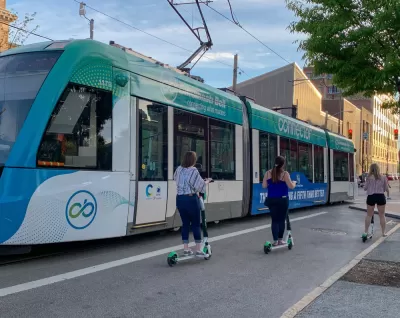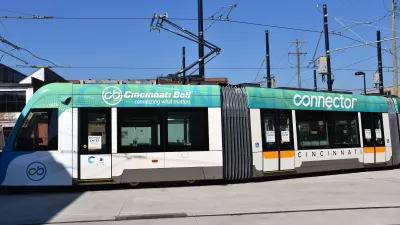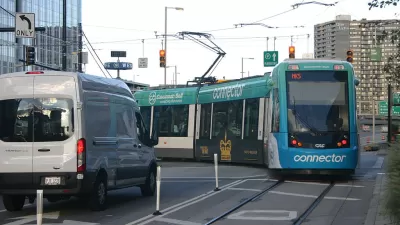The Cincinnati Streetcar, now known as the Cincinnati Connector, has come so far.

The Cincinnati Connector streetcar, which has attracted controversies and challenges since long before it opened in 2016, set a new ridership record in the month of October.
According to an article by Sharon Coolidge for the Cincinnati Enquirer, the Cincinnati Connector, née Cincinnati Bell Connector, served more than 100,000 monthly riders in October, thanks in part to a special four-day light festival called Blink that attracted 2 million people to the Over-the-Rhine neighborhood.
The Cincinnati Connector is on a little bit of a roll this year. “The ridership total for October was 103,700, eclipsing the streetcar’s previous all-time monthly high of 89,074 passengers set in July of this year, according to a city of Cincinnati press release.”
Prior to the pandemic, the news for the streetcar was mostly dire, with reports of service and fiscal failures dominating the news in 2018. Things started to turn around when the system was made free forever in 2020—a celebrity endorsement from Emilio Estevez didn’t hurt either.
FULL STORY: Cincinnati streetcar sets monthly ridership record

Alabama: Trump Terminates Settlements for Black Communities Harmed By Raw Sewage
Trump deemed the landmark civil rights agreement “illegal DEI and environmental justice policy.”

Study: Maui’s Plan to Convert Vacation Rentals to Long-Term Housing Could Cause Nearly $1 Billion Economic Loss
The plan would reduce visitor accommodation by 25% resulting in 1,900 jobs lost.

Why Should We Subsidize Public Transportation?
Many public transit agencies face financial stress due to rising costs, declining fare revenue, and declining subsidies. Transit advocates must provide a strong business case for increasing public transit funding.

Paris Bike Boom Leads to Steep Drop in Air Pollution
The French city’s air quality has improved dramatically in the past 20 years, coinciding with a growth in cycling.

Why Housing Costs More to Build in California Than in Texas
Hard costs like labor and materials combined with ‘soft’ costs such as permitting make building in the San Francisco Bay Area almost three times as costly as in Texas cities.

San Diego County Sees a Rise in Urban Coyotes
San Diego County experiences a rise in urban coyotes, as sightings become prevalent throughout its urban neighbourhoods and surrounding areas.
Urban Design for Planners 1: Software Tools
This six-course series explores essential urban design concepts using open source software and equips planners with the tools they need to participate fully in the urban design process.
Planning for Universal Design
Learn the tools for implementing Universal Design in planning regulations.
Smith Gee Studio
Alamo Area Metropolitan Planning Organization
City of Santa Clarita
Institute for Housing and Urban Development Studies (IHS)
City of Grandview
Harvard GSD Executive Education
Toledo-Lucas County Plan Commissions
Salt Lake City
NYU Wagner Graduate School of Public Service




























